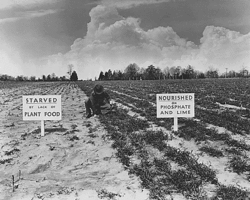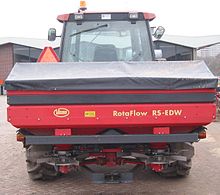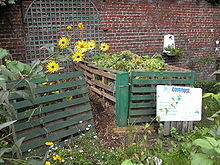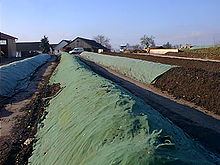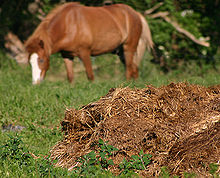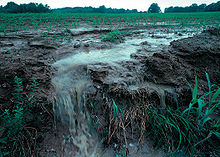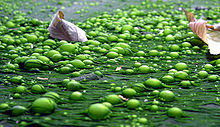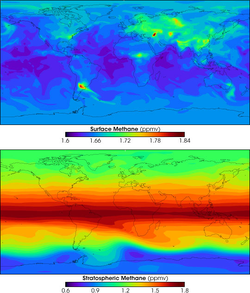- Fertilizer
-
Fertilizer (or fertiliser) is any organic or inorganic material of natural or synthetic origin (other than liming materials) that is added to a soil to supply one or more plant nutrients essential to the growth of plants.[1] A recent assessment found that about 40 to 60% of crop yields are attributable to commercial fertilizer use.[2]
Mined inorganic fertilizers have been used for many centuries, whereas chemically synthesized inorganic fertilizers were only widely developed during the industrial revolution. Increased understanding and use of fertilizers were important parts of the pre-industrial British Agricultural Revolution and the industrial Green Revolution of the 20th century.
Inorganic fertilizer use has also significantly supported global population growth — it has been estimated that almost half the people on the Earth are currently fed as a result of synthetic nitrogen fertilizer use.[3]
Fertilizers typically provide, in varying proportions:
- six macronutrients: nitrogen (N), phosphorus (P), potassium (K), calcium (Ca), magnesium (Mg), and sulfur (S);
- seven micronutrients: boron (B), chlorine (Cl), copper (Cu), iron (Fe), manganese (Mn), molybdenum (Mo), and zinc (Zn).
The macronutrients are consumed in larger quantities and are present in plant tissue in quantities from 0.15% to 6.0% on a dry matter (0% moisture) basis (DM). Micronutrients are consumed in smaller quantities and are present in plant tissue on the order of parts per million (ppm), ranging from 0.15 to 400 ppm DM, or less than 0.04% DM.[4][5]
Only three other macronutrients are required by all plants: carbon, hydrogen, and oxygen. These nutrients are supplied by water and carbon dioxide.
The nitrogen-rich fertilizer ammonium nitrate is also used as an oxidizing agent in improvised explosive devices, sometimes called fertilizer bombs, leading to sale regulations[citation needed].
Contents
Labeling
Main article: labeling of fertilizersThe labeling of fertilizers varies by country in terms of analysis methodology and subsequent nutrient labeling. In most countries the macronutrients are labeled with an NPK analysis (in Australia, "N-P-K-S" adding sulfur).[6]
The three numbers on the fertilizer label represent an analysis of the composition by weight. These three numbers correspond to nitrogen, phosphorus, and potassium (N-P-K) and always appear in that specific order. When a 4th number is included, it indicates the sulfur content (N-P-K-S).
While the number for "N" represents the percentage weight of nitrogen, the other two components are not for the analysis of the element, but rather, the analysis of the "available" or "soluble" form of the element. In traditional chemical analysis, the tests used treated the sample so as to measure the equivalent P2O5 and K2O. For instance, some potassium-bearing rocks do not count as having available potassium.
The number for "P" is actually the weight of an equivalent quantity of P2O5 and not elemental phosphorus. In order to calculate the weight of P in the formulation, the weight of P2O5 can be multiplied by 0.44 to compensate for the weight of the oxygen in the molecule. For example, a bag of 10-10-10 has 10 pounds of nitrogen, 10 pounds of P2O5, but only 4.4 pounds of P.
Likewise, the number for "K" is actually the weight of an equivalent quantity of K2O, and not elemental potassium. In order to calculate the weight of K in the formulation, the weight of K2O can be multiplied by 0.83 to compensate for the weight of the oxygen in the molecule. For example, a bag of 10-10-10 has 10 pounds of K2O, but only 8.3 pounds of K.
As an example, the fertilizer potash (in modern times, potassium chloride) is composed of 52% potassium and 48% chlorine by weight; chemical analysis of 100g of potassium chloride (KCl), would show 63g of equivalent potassium oxide (K2O) when done in the manner of fertilizer analysis. The percentage yield of K2O from the original 100g of fertilizer is the number shown on the label. A potash fertilizer would thus be labeled 0-0-63, and not 0-0-52.
History
The modern understanding of plant nutrition dates to the 19th century and the work of Justus von Liebig, among others. Management of soil fertility, however, has been the pre-occupation of farmers for thousands of years.
Forms
Fertilizers come in various forms. The most typical form is granular fertilizer (powder form). The next most common form is liquid fertilizer; some advantages of liquid fertilizer are its immediate effect and wide coverage. There are also slow-release fertilizers (various forms including fertilizer spikes, tabs, etc.) which reduce the problem of "burning" the plants due to excess nitrogen.
More recently, organic fertilizer is on the rise as people are resorting to environmental friendly (or 'green') products. Although organic fertilizer usually contain less nutrients, some people still prefer organic due to natural ingredients[citation needed].
Inorganic fertilizer (synthetic fertilizer)
Fertilizers are broadly divided into organic fertilizers (composed of enriched organic matter—plant or animal), or inorganic fertilizers (composed of synthetic chemicals and/or minerals).
Inorganic fertilizer is often synthesized using the Haber-Bosch process, which produces ammonia as the end product. This ammonia is used as a feedstock for other nitrogen fertilizers, such as anhydrous ammonium nitrate and urea. These concentrated products may be diluted with water to form a concentrated liquid fertilizer (e.g. UAN). Ammonia can be combined with rock phosphate and potassium fertilizer in the Odda Process to produce compound fertilizer.
The use of synthetic nitrogen fertilizers has increased steadily in the last 50 years, rising almost 20-fold to the current rate of 100 million tonnes of nitrogen per year.[7] The use of phosphate fertilizers has also increased from 9 million tonnes per year in 1960 to 40 million tonnes per year in 2000. A maize crop yielding 6-9 tonnes of grain per hectare requires 31–50 kg of phosphate fertilizer to be applied, soybean requires 20–25 kg per hectare.[8] Yara International is the world's largest producer of nitrogen based fertilizers.[9]
Controlled-release types
Urea and formaldehyde, reacted together to produce sparingly soluble polymers of various molecular weights, is one of the oldest controlled-nitrogen-release technologies, having been first produced in 1936 and commercialized in 1955.[10] The early product had 60 percent of the total nitrogen cold-water-insoluble, and the unreacted (quick release) less than 15%. Methylene ureas were commercialized in the 1960s and 1970s, having 25 and 60% of the nitrogen cold-water-insoluble, and unreacted urea nitrogen in the range of 15 to 30%. Isobutylidene diurea, unlike the methylurea polymers, is a single crystalline solid of relatively uniform properties, with about 90% of the nitrogen water-insoluble.
In the 1960s the National Fertilizer Development Center began developing Sulfur-coated urea; sulfur was used as the principle coating material because of its low cost and its value as a secondary nutrient.[10] Usually there is another wax or polymer which seals the sulfur; the slow release properties depend on the degradation of the secondary sealant by soil microbes as well as mechanical imperfections (cracks, etc.) in the sulfur. They typically provide 6 to 16 weeks of delayed release in turf applications. When a hard polymer is used as the secondary coating, the properties are a cross between diffusion-controlled particles and traditional sulfur-coated.
Other coated products use thermoplastics (and sometimes ethylene-vinyl acetate and surfactants, etc.) to produce diffusion-controlled release of urea or soluble inorganic fertilizers. "Reactive Layer Coating" can produce thinner, hence cheaper, membrane coatings by applying reactive monomers simultaneously to the soluble particles. "Multicote" is a process applying layers of low-cost fatty acid salts with a paraffin topcoat.
Besides being more efficient in the utilization of the applied nutrients, slow-release technologies also reduce the impact on the environment and the contamination of the subsurface water.[10]
Top users of nitrogen-based fertilizer[11] Country Total N use (Mt pa)
Amt. used (feed/pasture)
China 18.7 3.0 U.S. 9.1 4.7 France 2.5 1.3 Germany 2.0 1.2 Brazil 1.7 0.7 Canada 1.6 0.9 Turkey 1.5 0.3 U.K. 1.3 0.9 Mexico 1.3 0.3 Spain 1.2 0.5 Argentina 0.4 0.1 Application
Synthetic fertilizers are commonly used to treat fields used for growing maize, followed by barley, sorghum, rapeseed, soy and sunflower[citation needed]. One study has shown that application of nitrogen fertilizer on off-season cover crops can increase the biomass (and subsequent green manure value) of these crops, while having a beneficial effect on soil nitrogen levels for the main crop planted during the summer season.[12]
Nutrients in soil can be thrown out of balance with high concentrations of fertilizers. The interconnectedness and complexity of this soil ‘food web’ means any appraisal of soil function must necessarily take into account interactions with the living communities that exist within the soil. Stability of the system is reduced by the use of nitrogen-containing fertilizers, which cause soil acidification[citation needed].
Applying excessive amounts of fertilizer has negative environmental effects, and wastes the growers' time and money[citation needed]. To avoid over-application, the nutrient status of crops should be assessed. Nutrient deficiency can be detected by visually assessing the physical symptoms of the crop. Nitrogen deficiency, for example has a distinctive presentation in some species. However, quantitative tests are more reliable for detecting nutrient deficiency before it has significantly affected the crop. Both soil tests and Plant Tissue Tests are used in agriculture to fine-tune nutrient management to the crops needs.
Problems with inorganic fertilizer
Trace mineral depletion
Many inorganic fertilizers may not replace trace mineral elements in the soil which become gradually depleted by crops. This depletion has been linked to studies which have shown a marked fall (up to 75%) in the quantities of such minerals present in fruit and vegetables.[13]
In Western Australia deficiencies of zinc, copper, manganese, iron and molybdenum were identified as limiting the growth of broad-acre crops and pastures in the 1940s and 1950s[citation needed]. Soils in Western Australia are very old, highly weathered and deficient in many of the major nutrients and trace elements[citation needed]. Since this time these trace elements are routinely added to inorganic fertilizers used in agriculture in this state[citation needed].
Overfertilization
Over-fertilization of a vital nutrient can be as detrimental as underfertilization.[14] "Fertilizer burn" can occur when too much fertilizer is applied, resulting in a drying out of the roots and damage or even death of the plant.[15]
High energy consumption
In the USA in 2004, 317 billion cubic feet of natural gas was consumed in the industrial production of ammonia, less than 1.5% of total U.S. annual consumption of natural gas. [16] A 2002 report suggested that the production of ammonia consumes about 5% of global natural gas consumption, which is somewhat under 2% of world energy production.[17]
Ammonia is overwhelmingly produced from natural gas, but other energy sources, together with a hydrogen source, can be used for the production of nitrogen compounds suitable for fertilizers. The cost of natural gas makes up about 90% of the cost of producing ammonia.[18] The increase in price of natural gases over the past decade, along with other factors such as increasing demand, have contributed to an increase in fertilizer price.[19]
Long-Term Sustainability
Inorganic fertilizers are now produced in ways which theoretically cannot be continued indefinitely by definition as the resources used in their production are non-renewable. Potassium and phosphorus come from mines (or saline lakes such as the Dead Sea) and such resources are limited. However, more effective fertilizer utilization practices may decrease present usage from mines. Improved knowledge of crop production practices can potentially decrease fertilizer usage of P and K without reducing the critical need to improve and increase crop yields. Atmospheric (unfixed) nitrogen is effectively unlimited (forming over 70% of the atmospheric gases), but this is not in a form useful to plants. To make nitrogen accessible to plants requires nitrogen fixation (conversion of atmospheric nitrogen to a plant-accessible form).
Artificial nitrogen fertilizers are typically synthesized using fossil fuels such as natural gas and coal, which are limited resources. In lieu of converting natural gas to syngas for use in the Haber process, it is also possible to convert renewable biomass to syngas (or wood gas) to supply the necessary energy for the process, though the amount of land and resources (ironically often including fertilizer) necessary for such a project may be prohibitive.
Organic fertilizer
Organic fertilizers include naturally occurring organic materials, (e.g. manure, worm castings, compost, seaweed, guano), or naturally occurring mineral deposits (e.g. saltpeter).
Benefits of organic fertilizer
Organic fertilizers have been known to improve biodiversity (soil life) and long-term productivity of soil,[20][21] and may prove a large depository for excess carbon dioxide.[22][23][24]
Organic nutrients increase the abundance of soil organisms by providing organic matter and micronutrients for organisms such as fungal mycorrhiza,[25] (which aid plants in absorbing nutrients), and can drastically reduce external inputs of pesticides, energy and fertilizer, at the cost of decreased yield.[26]
Disadvantages of organic fertilizers
- Organic fertilizers may contain pathogens and other disease causing organisms if not properly composted
- Nutrient contents are very variable and their release to available forms that the plant can use may not occur at the right plant growth stage
- Organic fertilizers are comparatively voluminous and can be too bulky to deploy the right amount of nutrients that will be beneficial to plants
- More expensive to produce
Comparison with inorganic fertilizer
Organic fertilizer nutrient content, solubility, and nutrient release rates are typically all lower than inorganic fertilizers.[27][28] One study[which?] found that over a 140-day period, after 7 leachings:
- Organic fertilizers had released between 25% and 60% of their nitrogen content
- Controlled release fertilizers (CRFs) had a relatively constant rate of release
- Soluble fertilizer released most of its nitrogen content at the first leaching
In general, the nutrients in organic fertilizer are both more dilute and also much less readily available to plants. According to the University of California's integrated pest management program, all organic fertilizers are classified as 'slow-release' fertilizers, and therefore cannot cause nitrogen burn.[29]
Organic fertilizers from composts and other sources can be quite variable from one batch to the next.[30] Without batch testing, amounts of applied nutrient cannot be precisely known. Nevertheless they are at least as effective as chemical fertilizers over longer periods of use.[31]
Example of organic fertilizer
Chicken litter, which consists of chicken manure mixed with sawdust, is an organic fertilizer that has been shown to better condition soil for harvest than synthesized fertilizer. Researchers at the Agricultural Research Service (ARS) studied the effects of using chicken litter, an organic fertilizer, versus synthetic fertilizers on cotton fields, and found that fields fertilized with chicken litter had a 12% increase in cotton yields over fields fertilized with synthetic fertilizer. In addition to higher yields, researchers valued commercially sold chicken litter at a $17/ton premium (to a total valuation of $78/ton) over the traditional valuations of $61/ton due to value added as a soil conditioner.[32]
Other ARS studies have found that algae used to capture nitrogen and phosphorus runoff from agricultural fields can not only prevent water contamination of these nutrients, but also can be used as an organic fertilizer. ARS scientists originally developed the "algal turf scrubber" to reduce nutrient runoff and increase quality of water flowing into streams, rivers, and lakes. They found that this nutrient-rich algae, once dried, can be applied to cucumber and corn seedlings and result in growth comparable to that seen using synthetic fertilizers.[33]
Organic fertilizer sources
Animal
Animal-sourced and human urea are suitable for application organic agriculture, while pure synthetic forms of urea are not.[34][35] The common thread that can be seen through these examples is that organic agriculture attempts to define itself through minimal processing (in contrast to the man-made Haber process), as well as being naturally occurring or via natural biological processes such as composting.[citation needed]
Besides immediate application of urea to the soil, urine can also be improved by converting it to struvite already done with human urine by a Dutch firm.[36] The conversion is performed by adding magnesium to the urine. An added economical advantage of using urine as fertilizer is that it contains a large amount of phosphorus, a mineral whose production is rapidly decreasing (peak phosphorus) as the mines are running dry.
Sewage sludge (aka biosolids) use is only available to less than 1% of US ag[clarification needed] land. USDA prohibits use of sewage sludge in organic agricultural operations in the U.S. has been extremely limited and rare due to of the practice (due to toxic metal accumulation, among other factors).[37][38] The USDA now requires 3rd-party certification of high-nitrogen liquid organic fertilizers sold in the U.S.[39]
Plant
Leguminous cover crops are also grown to enrich soil as a green manure through nitrogen fixation from the atmosphere;[40] as well as phosphorus (through nutrient mobilization)[41] content of soils.
Mineral
Mined powdered limestone,[42] rock phosphate and sodium nitrate, are inorganic (not of biologic origins) compounds which are energetically intensive to harvest and are approved for usage in organic agriculture in minimal amounts.[42][43][44]
Negative environmental effects
Water quality
Eutrophication
The nitrogen-rich compounds found in fertilizer runoff is the primary cause of a serious depletion of oxygen in many parts of the ocean, especially in coastal zones; the resulting lack of dissolved oxygen is greatly reducing the ability of these areas to sustain oceanic fauna.[45] Visually, water may become cloudy and discolored (green, yellow, brown, or red).
About half of all the lakes in the United States are now eutrophic, while the number of oceanic dead zones near inhabited coastlines are increasing.[46] As of 2006, the application of nitrogen fertilizer is being increasingly controlled in Britain and the United States[citation needed]. If eutrophication can be reversed, it may take decades[citation needed] before the accumulated nitrates in groundwater can be broken down by natural processes.
Blue Baby Syndrome
High application rates of inorganic nitrogen fertilizers in order to maximize crop yields, combined with the high solubilities of these fertilizers leads to increased runoff into surface water as well as leaching into groundwater.[47][48][49] The use of ammonium nitrate in inorganic fertilizers is particularly damaging, as plants absorb ammonium ions preferentially over nitrate ions, while excess nitrate ions which are not absorbed dissolve (by rain or irrigation) into runoff or groundwater.[50]
Nitrate levels above 10 mg/L (10 ppm) in groundwater can cause 'blue baby syndrome' (acquired methemoglobinemia), leading to hypoxia (which can lead to coma and death if not treated).[51]
Soil
Soil acidification
Nitrogen-containing inorganic and organic fertilizers can cause soil acidification when added.[52] [4]. This may lead to decreases in nutrient availability which may be offset by liming.
Persistent organic pollutants
Main article: Persistent organic pollutantsToxic persistent organic pollutants ("POPs"), such as Dioxins, polychlorinated dibenzo-p-dioxins (PCDDs), and polychlorinated dibenzofurans (PCDFs) have been detected in agricultural fertilizers and soil amendments[53]
Heavy metal accumulation
The concentration of up to 100 mg/kg of cadmium in phosphate minerals (for example, minerals from Nauru[54] and the Christmas islands[55]) increases the contamination of soil with cadmium, for example in New Zealand.[56]
Steel industry wastes, recycled into fertilizers for their high levels of zinc (essential to plant growth), wastes can include the following toxic metals: lead[57] arsenic, cadmium,[57] chromium, and nickel. The most common toxic elements in this type of fertilizer are mercury, lead, and arsenic.[58][59] Concerns have been raised concerning fish meal mercury content by at least one source in Spain[60]
Radioactive element accumulation
Uranium is another example of a contaminant often found in phosphate fertilizers (at levels from 7 to 100 pCi/g).[61] Eventually these heavy metals can build up to unacceptable levels and build up in vegetable produce.[56] Average annual intake of uranium by adults is estimated to be about 0.5 mg (500 μg) from ingestion of food and water and 0.6 μg from breathing air.[62]
Also, highly radioactive Polonium-210 contained in phosphate fertilizers is absorbed by the roots of plants and stored in its tissues; tobacco derived from plants fertilized by rock phosphates contains Polonium-210 which emits alpha radiation estimated to cause about 11,700 lung cancer deaths each year worldwide.[63][64] [65][66][67][68]
For these reasons, it is recommended that nutrient budgeting, through careful observation and monitoring of crops, take place to mitigate the effects of excess fertilizer application.
Atmosphere
Methane emissions from crop fields (notably rice paddy fields) are increased by the application of ammonium-based fertilizers; these emissions contribute greatly to global climate change as methane is a potent greenhouse gas.[69]
Through the increasing use of nitrogen fertilizer, which is added at a rate of 1 billion tons per year presently[70] to the already existing amount of reactive nitrogen, nitrous oxide (N2O) has become the third most important greenhouse gas after carbon dioxide and methane. It has a global warming potential 296 times larger than an equal mass of carbon dioxide and it also contributes to stratospheric ozone depletion.[71]
Storage and application of some nitrogen fertilizers in some[which?] weather or soil conditions can cause emissions of the potent greenhouse gas—nitrous oxide. Ammonia gas (NH3) may be emitted following application of 'inorganic' fertilizers and/or manures and slurries.[citation needed]
The use of fertilizers on a global scale emits significant quantities of greenhouse gas into the atmosphere. Emissions come about through the use of:[72]
- animal manures and urea, which release methane, nitrous oxide, ammonia, and carbon dioxide in varying quantities depending on their form (solid or liquid) and management (collection, storage, spreading)
- fertilizers that use nitric acid or ammonium bicarbonate, the production and application of which results in emissions of nitrogen oxides, nitrous oxide, ammonia and carbon dioxide into the atmosphere.
By changing processes and procedures, it is possible to mitigate some, but not all, of these effects on anthropogenic climate change.[citation needed]
Other problems
Increased pest fitness
Excessive nitrogen fertilizer applications can also lead to pest problems by increasing the birth rate, longevity and overall fitness of certain agricultural pests, such as aphids (plant lice).[73][74][75][76][77][78]
See also
- Soil fertility
- Manure
- Organic fertilizer
- Fertigation
- NPK rating
- Fertilizer labeling
- Agriculture and the environment
- Phosphogypsum
References
- ^ "Glossary of Soil Science Terms". Soil Science Society of America. https://www.soils.org/publications/soils-glossary#. Retrieved May 10, 2011.
- ^ Stewart, W.M.; Dibb, D.W.; Johnston, A.E.; Smyth, T.J. (2005). "The Contribution of Commercial Fertilizer Nutrients to Food Production". Agronomy Journal 97: 1–6. doi:10.2134/agronj2005.0001
- ^ Erisman, Jan Willem; MA Sutton, J Galloway, Z Klimont, W Winiwarter (October 2008). "How a century of ammonia synthesis changed the world". Nature Geoscience 1 (10): 636. doi:10.1038/ngeo325. http://www.physics.ohio-state.edu/~wilkins/energy/Resources/Essays/ngeo325.pdf.xpdf. Retrieved 22 October 2010.
- ^ "AESL Plant Analysis Handbook - Nutrient Content of Plant". Aesl.ces.uga.edu. http://aesl.ces.uga.edu/publications/plant/Nutrient.htm. Retrieved 2010-08-25.
- ^ H.A. Mills, J.B. Jones Jr. (1996). Plant Analysis Handbook II: A practical Sampling, Preparation, Analysis, and Interpretation Guide. ISBN 1-878148-052.
- ^ "Draft Code of Practice for Fertilizer Description and Labeling". Fertilizer Industry Federation Association (FIFA). 2008-09-15. http://docs.google.com/viewer?a=v&q=cache:CgW191hwEBIJ:www.fifa.asn.au/files/pdf/regulation/Draft%2520Code%2520of%2520Practice%2520for%2520Fertilizer%2520Description%2520%26%2520Labelling.pdf+labeling+of+fertilizer&hl=en&gl=us&sig=AHIEtbSJjp1liw8XbwDLtw2aqua-xK0n1g. Retrieved 3 February 2010.
- ^ Glass, Anthony (September 2003). "Nitrogen Use Efficiency of Crop Plants: Physiological Constraints upon Nitrogen Absorption". Critical Reviews in Plant Sciences 22 (5): 453. doi:10.1080/713989757. http://www.ingentaconnect.com/content/tandf/bpts/2003/00000022/00000005/art00003.
- ^ Vance; Uhde-Stone & Allan (2003). "Phosphorus acquisition and use: critical adaptations by plants for securing a non renewable resource". New Phythologist (Blackwell Publishing) 157 (3): 423–447. doi:10.1046/j.1469-8137.2003.00695.x. JSTOR 1514050.
- ^ "Mergers in the fertiliser industry". The Economist. 18 February 2010. http://www.economist.com/businessfinance/displaystory.cfm?story_id=15549105. Retrieved 21 February 2010.
- ^ a b c J. B. Sartain, University of Florida ((c)2011). "Food for turf: Slow-release nitrogen". Grounds Maintenance. http://www.grounds-mag.com/mag/grounds_maintenance_food_turf_slowrelease/
- ^ United Nations Food and Agriculture Organization, Livestock's Long Shadow: Environmental Issues and Options, Table 3.3 retrieved 29 Jun 2009
- ^ Nitrogen Applied Newswise, Retrieved on October 1, 2008.
- ^ Lawrence, Felicity (2004). "214". In Kate Barker. Not on the Label. Penguin. p. 213. ISBN 0-14-101566-7.
- ^ Nitrogen Fertilization: General Information
- ^ Avoiding Fertilizer Burn
- ^ Aleksander Abram and D. Lynn Forster (2005). A Primer on Ammonia, Nitrogen Fertilizers, and Natural Gas Markets. Department of Agricultural, Environmental, and Development Economics, Ohio State University. p. 38
- ^ IFA - Statistics - Fertilizer Indicators - Details - Raw material reserves (2002-10. Retrieved 2007-04-21.
- ^ Sawyer JE (2001). "Natural gas prices affect nitrogen fertilizer costs". IC-486 1: 8. http://www.ipm.iastate.edu/ipm/icm/2001/1-29-2001/natgasfert.html.
- ^ "Table 8—Fertilizer price indexes, 1960-2007.". http://www.ers.usda.gov/Data/FertilizerUse/.
- ^ Enwall, Karin; Laurent Philippot,2 and Sara Hallin1 (December 2005). "Activity and Composition of the Denitrifying Bacterial Community Respond Differently to Long-Term Fertilization". Applied and Environmental Microbiology (American Society for Microbiology) 71 (2): 8335–8343. doi:10.1128/AEM.71.12.8335-8343.2005. PMC 1317341. PMID 16332820. http://aem.highwire.org/cgi/content/abstract/71/12/8335. Retrieved Feb 1 2010.
- ^ Birkhofera, Klaus; T. Martijn Bezemerb, c, d, Jaap Bloeme, Michael Bonkowskia, Søren Christensenf, David Duboisg, Fleming Ekelundf, Andreas Fließbachh, Lucie Gunstg, Katarina Hedlundi, Paul Mäderh, Juha Mikolaj, Christophe Robink, Heikki Setäläj, Fabienne Tatin-Frouxk, Wim H. Van der Puttenb, c and Stefan Scheua (September 2008). "Long-term organic farming fosters below and aboveground biota: Implications for soil quality, biological control and productivity". Soil Biology and Biochemistry (Soil Biology and Biochemistry) 40 (9): 2297–2308. doi:10.1016/j.soilbio.2008.05.007. http://www.sciencedirect.com/science?_ob=ArticleURL&_udi=B6TC7-4SR67X8-1&_user=10&_coverDate=09%2F30%2F2008&_rdoc=1&_fmt=high&_orig=search&_sort=d&_docanchor=&view=c&_searchStrId=1189586172&_rerunOrigin=scholar.google&_acct=C000050221&_version=1&_urlVersion=0&_userid=10&md5=835b56d01da86058b98352b95f68d2d8. Retrieved Feb 1, 2010.
- ^ Lal, R. (2004). "Soil Carbon Sequestration Impacts on Global Climate Change and Food Security". Science (Science (journal)) 304 (5677): 1623–7. doi:10.1126/science.1097396. PMID 15192216. http://www.sciencemag.org/cgi/content/abstract/sci;304/5677/1623.
- ^ Rees, Eifion (3 July 2009). "Change farming to cut CO2 emissions by 25 per cent". The Ecologist. http://www.theecologist.org/News/news_analysis/280491/change_farming_to_cut_co2_emissions_by_25_per_cent.html. Retrieved 2 February 2010.
- ^ Fliessbach, A.; P Maeder(2), A Diop(3), LWM Luttikholt(1), N Scialabba(4), U Niggli(2), Paul Hepperly(3), T LaSalle(3) (2009). "ClimateChange: GlobalRisks,ChallengesandDecisions". P24.17 Mitigation and adaptation strategies – organic agriculture. IOPConf. Series: EarthandEnvironmentalScience6(2009)242025: IOP Publishing. http://www.iop.org/EJ/article/1755-1315/6/24/.../ees9_6_242025.pdf. Retrieved 2 February 2010.
- ^ PIMENTEL, David; PAUL HEPPERLY, JAMES HANSON, DAVID DOUDS, and RITA SEIDEL (July 2005). "Environmental, Energetic, and Economic Comparisons of Organic and Conventional Farming Systems". BioScience. pp. ol. 55, No. 7, Pages 573–582. http://caliber.ucpress.net/doi/abs/10.1641/0006-3568(2005)055%5B0573:EEAECO%5D2.0.CO;2. Retrieved 2 February 2010.
- ^ Mäder, Paul; Andreas Fliebach,,1 David Dubois,2 Lucie Gunst,2 Padruot Fried,2 Urs Niggli1 (31 May 2002). "Soil Fertility and Biodiversity in Organic Farming". Science (Science) 296 (5573): 1694–1697. doi:10.1126/science.1071148. PMID 12040197. http://www.sciencemag.org/cgi/content/abstract/296/5573/1694. Retrieved February 1, 2010.
- ^ "Acta Horticulturae". Actahort.org. http://www.actahort.org/members/showpdf?booknrarnr=644_20. Retrieved 2010-08-25.
- ^ "AZ Master Gardener Manual: Organic Fetilizers". Ag.arizona.edu. http://ag.arizona.edu/pubs/garden/mg/soils/organic.html. Retrieved 2010-08-25.
- ^ "Healthy LawnsFertilizers vs. soil amendments". Ipm.ucdavis.edu. http://www.ipm.ucdavis.edu/TOOLS/TURF/SITEPREP/amenfert.html. Retrieved 2010-08-25.
- ^ "Crazy about Compost" (PDF). http://www.msuorganicfarm.com/Compost.pdf. Retrieved 2010-08-25.
- ^ "CSA". Md1.csa.com. http://md1.csa.com/partners/viewrecord.php?requester=gs&collection=TRD&recid=0002290EN&q=http%3A%2F%2Fwww.csa.com%2Fpartners%2Fviewrecord.php%3Frequester%3Dgs%26collection%3DTRD%26recid%3D0002290EN&uid=789131166&setcookie=yes. Retrieved 2010-08-25.
- ^ "Researchers Study Value of Chicken Litter in Cotton Production". July 23, 2010. http://www.ars.usda.gov/is/pr/2010/100623.htm.
- ^ "Algae: A Mean, Green Cleaning Machine". USDA Agricultural Research Service. May 7, 2010. http://www.ars.usda.gov/is/AR/archive/may10/algae0510.htm.
- ^ "In a natural organic system, nitrate in the soil is derived from the gradual breakdown of humus". Ecochem.com. http://www.ecochem.com/t_natfert.html. Retrieved 2010-08-25.
- ^ "Why not utilize urea as a source of N in organic agriculture. | Neves, M. C. P., De-Polli, H., Peixoto, R. T. dos G., Almeida, D. L. de | CC&T, Cadernos de Ciência & Technologia | Empresa Brasileira de Pesquisa Agropecuária". Cababstractsplus.org. 2007-04-27. http://www.cababstractsplus.org/abstracts/Abstract.aspx?AcNo=20023145231. Retrieved 2010-08-25.
- ^ Human urine conversion to struvite
- ^ "Organic Farming | Agriculture | US EPA". Epa.gov. http://www.epa.gov/oecaagct/torg.html. Retrieved 2010-08-25.
- ^ "CalOrganic Farms News". Calorganicfarms.com. http://www.calorganicfarms.com/news/full.php?id=22. Retrieved 2010-08-25.
- ^ Schrack, Don (2009-02-23). "USDA Toughens Oversight of Organic Fertilizer: Organic fertilizers must undergo testing". The Packer. http://www.organicconsumers.org/articles/article_17001.cfm. Retrieved 19 November 2009.
- ^ USA (2010-07-06). "Isolation and Study of Cultures of Chinese Vetch Nodule Bacteria". Pubmedcentral.nih.gov. http://www.pubmedcentral.nih.gov/pagerender.fcgi?artid=373994&pageindex=6#page. Retrieved 2010-08-25.
- ^ Uphoff, Norman Thomas (2006). Biological approaches to sustainable ... - Google Books. ISBN 9781574445831. http://books.google.com/?id=XO3pio5Opy8C&pg=PA564&lpg=PA564&dq=phosphorus+addition+fava+bean. Retrieved 2010-08-25.
- ^ a b http://google.com/search?q=cache:_KrbNzgsjrQJ:extension.agron.iastate.edu/sustag/pubs/Soil_Quality_Brochure.doc+limestone+organic+agriculture&cd=3&hl=en&ct=clnk&gl=us&client=opera
- ^ "Can I Use This Input on My Organic Farm?". eXtension. http://www.extension.org/article/18321/print/. Retrieved 2010-08-25.
- ^ Alternative Farming Systems Information Center. "Organic Production and Organic Food: Information Access Tools". Nal.usda.gov. http://www.nal.usda.gov/afsic/pubs/ofp/ofp.shtml#resources. Retrieved 2010-08-25.
- ^ "Rapid Growth Found in Oxygen-Starved Ocean ‘Dead Zones’", NY Times, Aug. 14, 2008
- ^ John Heilprin, Associated Press. "Discovery Channel :: News - Animals :: U.N.: Ocean 'Dead Zones' Growing". Dsc.discovery.com. http://dsc.discovery.com/news/2006/10/20/deadzone_pla.html. Retrieved 2010-08-25.
- ^ C. J. Rosen and B. P. Horgan (2009-01-09). "Preventing Pollution Problems from Lawn and Garden Fertilizers". Extension.umn.edu. http://www.extension.umn.edu/distribution/horticulture/DG2923.html. Retrieved 2010-08-25.
- ^ http://www.sciencedirect.com/science?_ob=ArticleURL&_udi=B6V94-3VW172B-1&_user=10&_rdoc=1&_fmt=&_orig=search&_sort=d&view=c&_acct=C000050221&_version=1&_urlVersion=0&_userid=10&md5=a887208bd6509db7ab1557a4fc43c5fa
- ^ "NOFA Interstate Council: The Natural Farmer. Ecologically Sound Nitrogen Management. Mark Schonbeck". Nofa.org. 2004-02-25. http://www.nofa.org/tnf/nitrogen.php. Retrieved 2010-08-25.
- ^ Roots, Nitrogen Transformations, and Jillesha Services Annual Review of Plant Biology Vol. 59: 341-363
- ^ Lynda Knobeloch, Barbara Salna, Adam Hogan, Jeffrey Postle, and Henry Anderson. "Blue Babies and Nitrate-Contaminated Well Water". Ehponline.org. http://www.ehponline.org/docs/2000/108p675-678knobeloch/abstract.html. Retrieved 2010-08-25.
- ^ http://www.sciencemag.org/cgi/content/full/324/5928/721-b#R1
- ^ pg 33: http://www.epa.gov/osw/hazard/recycling/fertiliz/risk/
- ^ Syers JK, Mackay AD, Brown MW, Currie CD (1986). "Chemical and physical characteristics of phosphate rock materials of varying reactivity". J Sci Food Agric 37 (11): 1057–1064. doi:10.1002/jsfa.2740371102.
- ^ Trueman NA (1965). "The phosphate, volcanic and carbonate rocks of Christmas Island (Indian Ocean)". J Geol Soc Aust 12: 261–286.
- ^ a b Taylor MD (1997). "Accumulation of Cadmium derived from fertilizers in New Zealand soils". Science of Total Environment 208: 123–126. doi:10.1016/S0048-9697(97)00273-8.
- ^ a b Wilson, Duff (1997-07-03). "Business | Fear In The Fields - How Hazardous Wastes Become Fertilizer - Spreading Heavy Metals On Farmland Is Perfectly Legal, But Little Research Has Been Done To Find Out Whether It's Safe | Seattle Times Newspaper". Community.seattletimes.nwsource.com. http://community.seattletimes.nwsource.com/archive/?date=19970703&slug=2547772. Retrieved 2010-08-25.
- ^ "Waste Lands: The Threat Of Toxic Fertilizer". Pirg.org. 1997-07-03. http://www.pirg.org/toxics/reports/wastelands/. Retrieved 2010-08-25.
- ^ mindfully.org. "Waste Lands: The Threat of Toxic Fertilizer Released by PIRG Toxic Wastes Found in Fertilizers Cat Lazaroff / ENS 7may01". Mindfully.org. http://www.mindfully.org/Farm/Toxic-Waste-Fertilizers.htm. Retrieved 2010-08-25.
- ^ "The catfish 'Toxic' suitable for fishmeal production". NowPublic. November 16, 2009. http://www.nowpublic.com/environment/catfish-toxic-suitable-fishmeal-production. Retrieved 23 November 2009.
- ^ "Radiation Protection:Fertilizer and Fertilizer Production Wastes". US EPA. March 11, 2009. http://www.epa.gov/rpdweb00/glossary/termuvwxyz.html#uranium. Retrieved 2 February 2010.
- ^ "Depleted uranium: Intake of depleted uranium". World Health Organization (WHO). January 2003. http://www.who.int/mediacentre/factsheets/fs257/en/. Retrieved 2 February 2010.
- ^ Hussein EM (1994). "Radioactivity of phosphate ore, superphosphate, and phosphogypsum in Abu-zaabal phosphate". Health Physics 67 (3): 280–282. doi:10.1097/00004032-199409000-00010. PMID 8056596.
- ^ Barisic D, Lulic S, Miletic P (1992). "Radium and uranium in phosphate fertilizers and their impact on the radioactivity of waters". Water Research 26 (5): 607–611. doi:10.1016/0043-1354(92)90234-U.
- ^ Scholten LC, Timmermans CWM (1992). "Natural radioactivity in phosphate fertilizers". Nutrient cycling in agroecosystems 43: 103–107. doi:10.1007/BF00747688.
- ^ American Public Health Association, Framing Health Matters, Waking a Sleeping Giant: The Tobacco Industry’s Response to the Polonium-210 Issue: Monique E. Muggli, MPH, Jon O. Ebbert, MD, Channing Robertson, PhD and Richard D. Hurt, MD [1]
- ^ Journal of the Royal Society of Medicine, The big idea: polonium, radon and cigarettes, Tidd J R Soc Med.2008; 101: 156-157 [2]
- ^ The Age Melbourne Australia, Big Tobacco covered up radiation danger, William Birnbauer [3]
- ^ Bodelier, Paul, L.E.; Peter Roslev3, Thilo Henckel1 & Peter Frenzel1 (November 1999). "Stimulation by ammonium-based fertilizers of methane oxidation in soil around rice roots". Nature 403 (6768): 421–424. doi:10.1038/35000193. PMID 10667792. http://www.nature.com/nature/journal/v403/n6768/abs/403421a0.html. Retrieved Feb 2, 2009.
- ^ http://www.nature.com/nature/journal/v451/n7176/fig_tab/nature06592_F1.html An Earth-system perspective of the global nitrogen cycle Nicolas Gruber & James N. Galloway Nature 451, 293-296(17 January 2008) doi:10.1038/nature06592
- ^ "Human alteration of the nitrogen cycle, threats, benefits and opportunities" UNESCO - SCOPE Policy briefs, April 2007
- ^ Food and Agricultural Organization of the U.N. retrieved 9 Aug 2007
- ^ Jahn GC (2004). "Effect of soil nutrients on the growth, survival and fecundity of insect pests of rice: an overview and a theory of pest outbreaks with consideration of research approaches. Multitrophic interactions in Soil and Integrated Control". International Organization for Biological Control (IOBC) wprs Bulletin 27 (1): 115–122.
- ^ Jahn GC, Sanchez ER, Cox PG (2001). "The quest for connections: developing a research agenda for integrated pest and nutrient management". International Rice Research Institute - Discussion Paper 42: 18. http://www.irri.org/publications/discussion/pdfs/DiscPaper42.pdf.
- ^ Jahn GC, Cox PG, Rubia-Sanchez E, Cohen M (2001). "The quest for connections: developing a research agenda for integrated pest and nutrient management. pp. 413-430,". S. Peng and B. Hardy [eds.] "Rice Research for Food Security and Poverty Alleviation". Proceeding the International Rice Research Conference, 31 March – 3 April 2000, Los Baños, Philippines. Los Baños (Philippines): International Rice Research Institute.: 692.
- ^ Jahn GC, Almazan LP, Pacia J (2005). "Effect of nitrogen fertilizer on the intrinsic rate of increase of the rusty plum aphid, Hysteroneura setariae (Thomas) (Homoptera: Aphididae) on rice (Oryza sativa L.)". Environmental Entomology 34 (4): 938–943. doi:10.1603/0046-225X-34.4.938. http://puck.esa.catchword.org/vl=33435372/cl=21/nw=1/rpsv/cw/esa/0046225x/v34n4/s26/p938.
- ^ Preap V, Zalucki MP, Nesbitt HJ, Jahn GC (2001). "Effect of fertilizer, pesticide treatment, and plant variety on realized fecundity and survival rates of Nilaparvata lugens (Stål); Generating Outbreaks in Cambodia". Journal of Asia Pacific Entomology 4 (1): 75–84. doi:10.1016/S1226-8615(08)60107-7.
- ^ Preap V, Zalucki MP, Jahn GC (2002). "Effect of nitrogen fertilizer and host plant variety on fecundity and early instar survival of Nilaparvata lugens (Stål): immediate response". Proceedings of the 4th International Workshop on Inter-Country Forecasting System and Management for Planthopper in East Asia. 13–15 November 2002. Guilin China. Published by Rural Development Administration (RDA) and the Food and Agriculture Organization (FAO): 163–180, 226.
External links
 Media related to Fertilizers at Wikimedia Commons
Media related to Fertilizers at Wikimedia Commons- Nitrogen for Feeding Our Food, Its Earthly Origin, Haber Process
- The Fertilizer Institute (TFI) US Fertilizer Industry Association
- International Fertilizer Industry Association (IFA)
- European Fertiliser Manufacturers Association
- How to read fertilizer tags article
- Agriculture Guide, Complete Guide to Fertilizers and Fertilization
Categories:- Fertilizers
Wikimedia Foundation. 2010.

